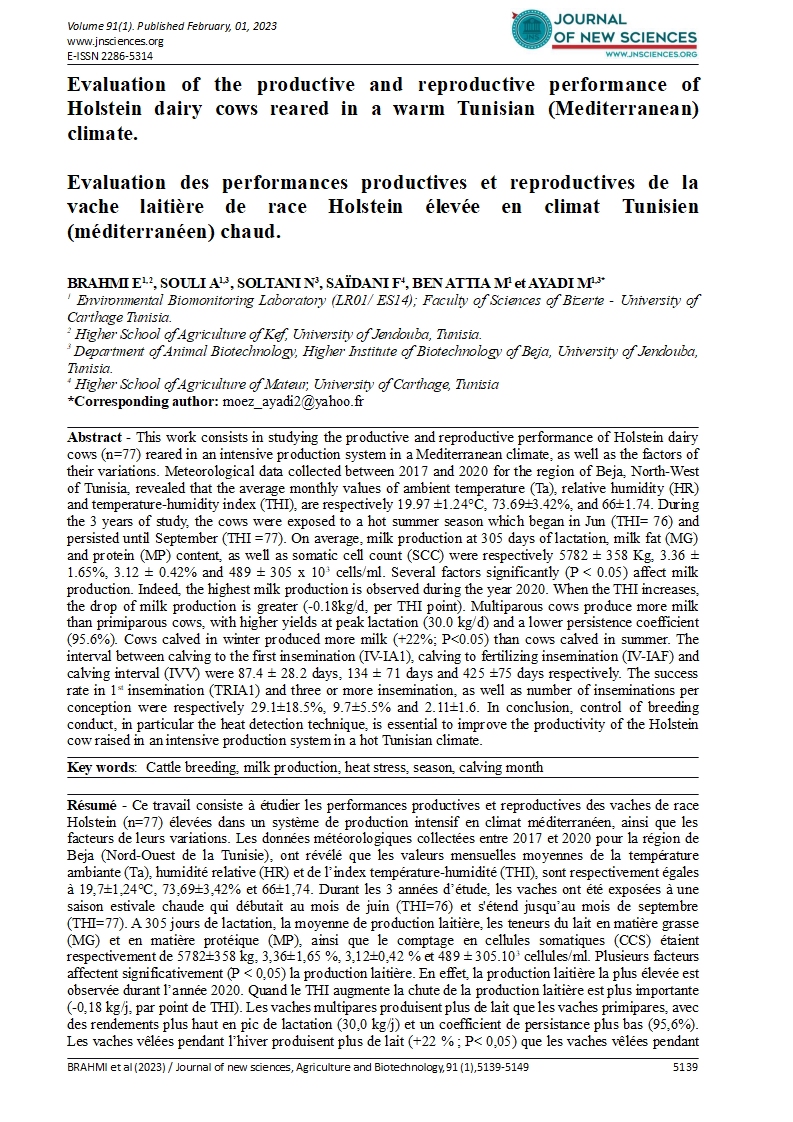

- Category: Volume 91
- Hits: 2890
Evaluation of the productive and reproductive performance of Holstein dairy cows reared in a warm Tunisian (Mediterranean) climate
Evaluation des performances productives et reproductives de la vache laitière de race Holstein élevée en climat Tunisien (méditerranéen) chaud.
BRAHMI E1,2
SOULI A1,3
SOLTANI N3
SAÏDANI F4
BEN ATTIA M1 et AYADI M1,3
1 Environmental Biomonitoring Laboratory (LR01/ ES14); Faculty of Sciences of Bizerte - University of Carthage Tunisia.
2 Higher School of Agriculture of Kef, University of Jendouba, Tunisia.
3 Department of Animal Biotechnology, Higher Institute of Biotechnology of Beja, University of Jendouba, Tunisia.
4 Higher School of Agriculture of Mateur, University of Carthage, Tunisia
DOI: https://doi.org/10.55416/sunb.jns01.2302.09101
Abstract - This work consists in studying the productive and reproductive performance of Holstein dairy cows (n=77) reared in an intensive production system in a Mediterranean climate, as well as the factors of their variations. Meteorological data collected between 2017 and 2020 for the region of Beja, North-West of Tunisia, revealed that the average monthly values of ambient temperature (Ta), relative humidity (HR) and temperature-humidity index (THI), are respectively 19.97 ±1.24°C, 73.69±3.42%, and 66±1.74. During the 3 years of study, the cows were exposed to a hot summer season which began in Jun (THI= 76) and persisted until September (THI =77). On average, milk production at 305 days of lactation, milk fat (MG) and protein (MP) content, as well as somatic cell count (SCC) were respectively 5782 ± 358 Kg, 3.36 ± 1.65%, 3.12 ± 0.42% and 489 ± 305 x 103 cells/ml. Several factors significantly (P < 0.05) affect milk production. Indeed, the highest milk production is observed during the year 2020. When the THI increases, the drop of milk production is greater (-0.18kg/d, per THI point). Multiparous cows produce more milk than primiparous cows, with higher yields at peak lactation (30.0 kg/d) and a lower persistence coefficient (95.6%). Cows calved in winter produced more milk (+22%; P<0.05) than cows calved in summer. The interval between calving to the first insemination (IV-IA1), calving to fertilizing insemination (IV-IAF) and calving interval (IVV) were 87.4 ± 28.2 days, 134 ± 71 days and 425 ±75 days respectively. The success rate in 1st insemination (TRIA1) and three or more insemination, as well as number of inseminations per conception were respectively 29.1±18.5%, 9.7±5.5% and 2.11±1.6. In conclusion, control of breeding conduct, in particular the heat detection technique, is essential to improve the productivity of the Holstein cow raised in an intensive production system in a hot Tunisian climate.
Key words: Cattle breeding, milk production, heat stress, season, calving month
Résumé - Ce travail consiste à étudier les performances productives et reproductives des vaches de race Holstein (n=77) élevées dans un système de production intensif en climat méditerranéen, ainsi que les facteurs de leurs variations. Les données météorologiques collectées entre 2017 et 2020 pour la région de Beja (Nord-Ouest de la Tunisie), ont révélé que les valeurs mensuelles moyennes de la température ambiante (Ta), humidité relative (HR) et de l’index température-humidité (THI), sont respectivement égales à 19,7±1,24°C, 73,69±3,42% et 66±1,74. Durant les 3 années d’étude, les vaches ont été exposées à une saison estivale chaude qui débutait au mois de juin (THI=76) et s'étend jusqu’au mois de septembre (THI=77). A 305 jours de lactation, la moyenne de production laitière, les teneurs du lait en matière grasse (MG) et en matière protéique (MP), ainsi que le comptage en cellules somatiques (CCS) étaient respectivement de 5782±358 kg, 3,36±1,65 %, 3,12±0,42 % et 489 ± 305.103 cellules/ml. Plusieurs facteurs affectent significativement (P < 0,05) la production laitière. En effet, la production laitière la plus élevée est observée durant l’année 2020. Quand le THI augmente la chute de la production laitière est plus importante (-0,18 kg/j, par point de THI). Les vaches multipares produisent plus de lait que les vaches primipares, avec des rendements plus haut en pic de lactation (30,0 kg/j) et un coefficient de persistance plus bas (95,6%). Les vaches vêlées pendant l’hiver produisent plus de lait (+22 % ; P< 0,05) que les vaches vêlées pendant l’été. Les intervalles vêlage 1ère insémination (IV-IA1), vêlage insémination fécondante (IV-IAF) et vêlage-vêlage (IV-V) ont été respectivement de 87,4 ± 28,2, 134 ± 71 et 425 ± 75 jours. Le taux de réussite en 1ère IA (TRIA1) et en 3 IA et plus, ainsi que l’indice coïtale (IC) étaient respectivement de 29,1±18,5%, 9,7±5,5% et 2,11±1,6%. En conclusion, la maîtrise de la conduite de reproduction, en particulier la technique de détection des chaleurs, est indispensable pour améliorer la productivité de la vache Holstein élevée dans un système de production intensif en climat tunisien chaud.
Mots clés : Elevage bovin, production laitière, stress thermique, saison, mois de vêlage

